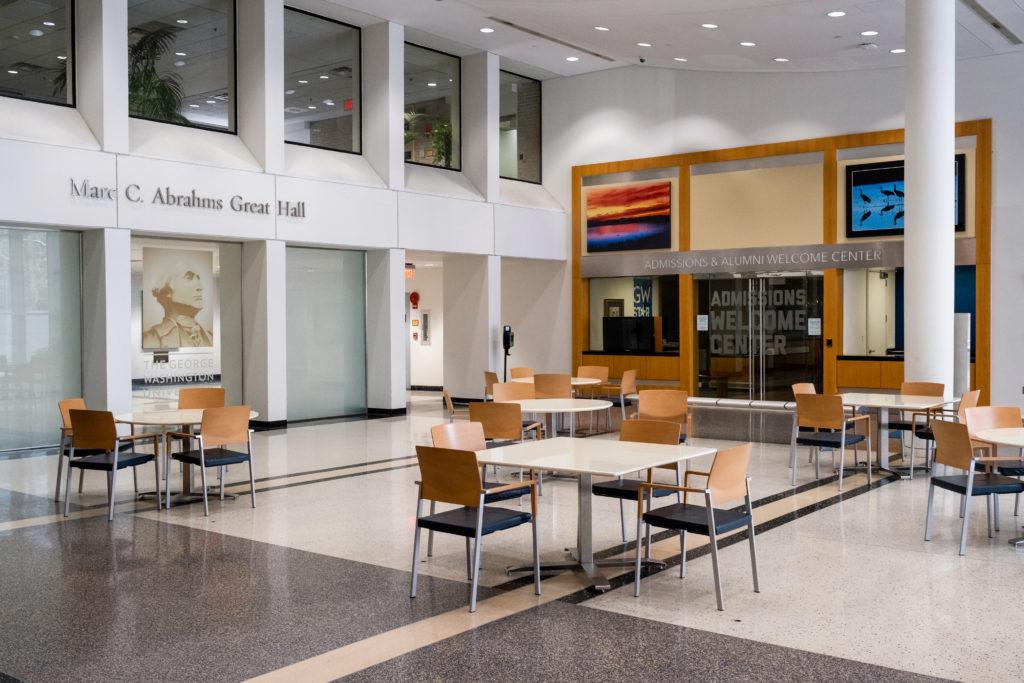Experts said the University’s international student enrollment numbers will continue to see the pandemic’s effects even as officials move to return fully in person this fall.
GW’s undergraduate international student enrollment this academic year fell slightly below its peer institutions and the national average, dropping by 18.4 percent compared to a 16 percent national decline. Experts in international student recruitment said next fall’s enrollment numbers are unlikely to jump up to pre-pandemic numbers because of difficulties with students’ visas and U.S. political security as the pandemic continues through 2021.
Other peer institutions like Georgetown and Syracuse universities saw less than 10 percent drops in international enrollment numbers, according to their enrollment dashboards. Tulane University and the University of Southern California both saw an increase in international students by about 5 percent, according to their enrollment data.
Five peer schools have not yet updated their enrollment data online for this academic year, according to their enrollment dashboards.
The Institute of International Education, in collaboration with nine higher education associations like the College Board, found that international enrollment dropped by 16 percent nationwide compared to last academic year. GW’s undergraduate international enrollment fell below the surveyed average, dropping from just more than 1,400 students last year to about 1,150 this past fall.
William Fish, the president of the Washington International Education Council, said universities benefit from international attendees in part because many of those students will pay their full tuition, which supports the schools’ endowment funds. He said colleges like GW will need to be “competitive” with their recruitment tactics to recover their numbers through methods like traveling to and promoting their programs in other countries.
“Many countries appreciate what international students bring,” Fish said. “First of all, they make a huge financial contribution to the U.S. economy. A lot of people are under the mistaken belief that most international students get scholarships or they get a free ride from someone. And that’s not at all the case. About 70 percent of international students are paying with family funds coming from overseas into the U.S. economy.”
Officials said last spring that they would take steps like growing the size of the waitlist and accepting more transfer students to mitigate the effects of changes to student enrollment that fall, including a drop in international students.
Fish added that international students equally benefit from attending colleges in the United States because many believe there are more opportunities throughout college for professional growth than in other countries. But countries like England and Canada have pushed successful recruitment tactics in recent years the United States has not used, like smoother visa processes, to attract more international students, he said.
He said GW could admit more domestic students to offset the lack of international students attending next fall, but the difference might not be made up. He said university finances are hurt by enrolling fewer international students, who are less likely to require financial aid than domestic students.
Administrators said GW is on track to accept its largest freshman applicant pool ever this year, with a 5 percent increase in domestic student applications. Although the total number of applications is at an all-time high, the number of international applications is down compared to this time last year, officials said.
“If you look at most of the information that’s available, most international students say that the U.S. is their priority country,” Fish said. “And if they could come here, they would rather come here.”
Ben Olsoe, the program coordinator for the Asian-American educational studies center at Virginia Commonwealth University, said in addition to safety concerns, racism and U.S. political conflicts under former President Donald Trump’s term have deterred international students from learning in the states.
GW’s total international enrollment dropped for the first time in at least nine years in 2017. Olsoe said recent hate crimes against Asian Americans have also stoked fears abroad, which may cause international students to shift the scope of their desired university.
“If a student came here and they experienced a racist hate crime, I wouldn’t be surprised if they would go home and not come back,” Olsoe said.
Kristi Marchesani, the assistant director of international admissions at the University of Northern Iowa, said her university’s biggest challenge this fall was bringing back international students whose embassies were shut down because of the pandemic. After some foreign embassies closed due to COVID-19 concerns, students struggled to get their F-1 Visa, which allows them to attend school in the United States.
Marchesani said she predicts a pileup in visas once more universities like GW that were virtual this entire academic year reopen and international students begin to apply.
“Even if the embassies are opening, there is going to be a huge backlog, so a student might not even be able to get in by the time school starts in the fall,” she said. “So, you may be looking at another semester where they can’t come in the fall, even though we are helping and welcoming them.”
She said UNI launched a program that offered lessons about studying from abroad and tuition scholarships, to target international students hesitant about enrolling.
“To be honest, the biggest barriers right now are the U.S. embassies being open, having available appointments and [international students’] perceptions to things they are more fearful about like COVID or safety issues,” Marchesani said. “We are happy that we are on campus, but I don’t know if that will shift students’ focus.”








